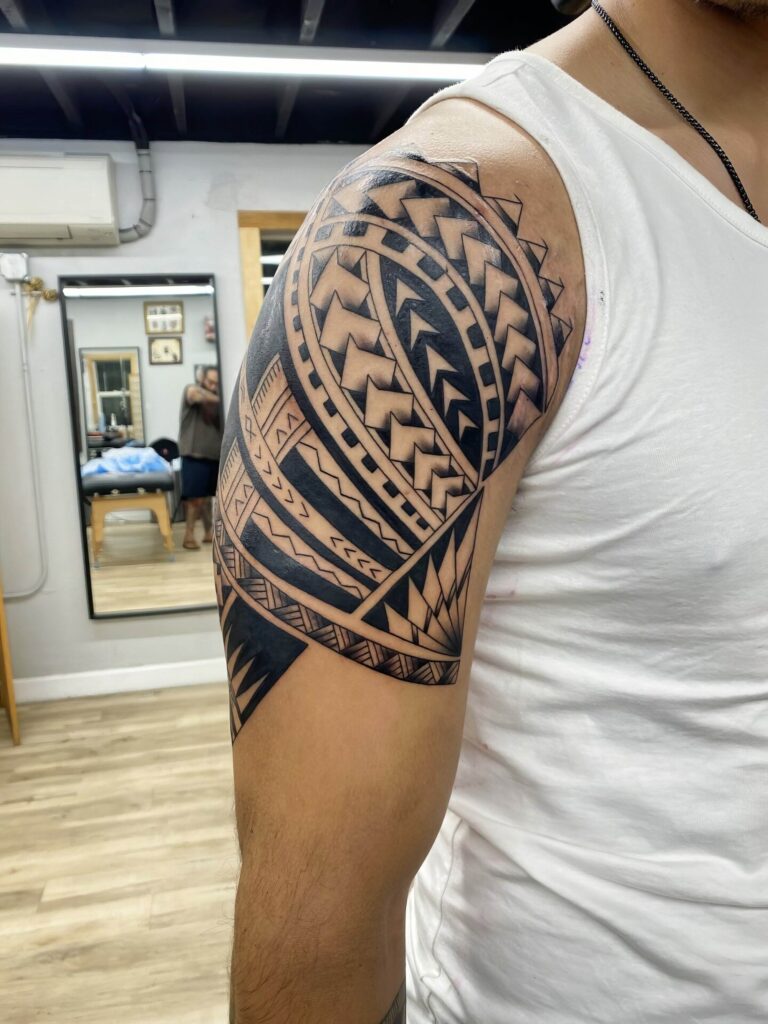
Introduction: Understanding Sleeve Tattoos
What is a Sleeve Tattoo?
A sleeve tattoo is a significant and intricate form of body art that covers a substantial portion of the arm, resembling the look of a sleeve on a shirt. Depending on the wearer’s preference, sleeve tattoos can be wholly or partially inked, extending from the shoulder to the wrist or just covering part of the arm. Key features of sleeve tattoos:
- Design Complexity: Often comprised of multiple designs that tell a story or convey a specific theme, sleeve tattoos can incorporate various motifs, colors, and styles.
- Customization: Each tattoo is typically personalized, allowing individuals to express their identity, values, and beliefs.
- Visual Impact: Sleeve tattoos are inherently eye-catching, making them one of the most popular forms of body art in contemporary society.
Given their scale, sleeve tattoos often require several sessions to complete, allowing for ample planning and creativity in portraying the desired symbols and images.
History of Sleeve Tattoos
The history of sleeve tattoos traces back centuries, with diverse cultural significance across the globe. In ancient civilizations, such as in Japan and Polynesia, tattooing was not just an art form but a rite of passage, a mark of social status, or a method of storytelling. Notable historical insights include:
- Japanese Irezumi: In Japan, intricate full-arm pieces known as irezumi emerged. These tattoos often depict mythical creatures, natural elements, and historical figures, carrying deep cultural meanings and personal stories of the wearers.
- Western Influence: In the West, sleeve tattoos gained popularity among sailors and the military. They often represented achievements, memorials of lost comrades, or symbols of protection.
- Mainstream Popularity Today: In recent decades, sleeve tattoos have transcended their traditional roots, becoming mainstream in popular culture. Celebrities and influencers sporting sleeves have contributed to their acceptance, transforming them into a unique form of self-expression.
Factors driving the contemporary rise of sleeve tattoos:
- Cultural Acceptance: Society has increasingly embraced body art, viewing it less as a taboo and more as an expressive medium.
- Artistic Innovation: Tattoo technology and artistry have evolved, allowing for more detailed and vibrant designs, appealing to a broader audience.
- Community and Identity: Many wearers find a sense of belonging within the tattoo community, creating connections through shared appreciation for body art.
Understanding sleeve tattoos goes beyond their aesthetic appeal; it encompasses a rich tapestry of history, culture, and personal narratives, making them a profound element of individual expression. As interest continues to grow, exploring the nuances of design and implications of placement becomes essential for those considering this transformative art form.
Planning Your Sleeve Tattoo Design
As you delve deeper into the world of sleeve tattoos, proper planning becomes crucial. The journey of creating your unique piece of art is both exciting and intricate. Today, we’ll explore two critical aspects of planning your sleeve tattoo: placement considerations and style & theme selection.
Placement Considerations
Placement is a vital aspect of your sleeve tattoo that can influence its visibility, comfort, and overall impact. Here are some factors to contemplate:
- Full vs. Half Sleeves: Decide if you want a full sleeve covering the entire arm or a half sleeve that extends from the shoulder to the elbow or from the elbow to the wrist. This choice will affect how you design your tattoo, as well as the time and commitment involved in establishing the artwork.
- Visibility and Professional Setting: Consider your daily environment. Will your sleeve be prominent in a professional setting, or do you work in a creative field where body art is celebrated? This will inform how visible your tattoo will be and may affect your design choices.
- Comfort and Sensitivity: The inner arm and areas around the elbow can be more sensitive. Keep in mind your pain tolerance and any discomfort you might experience during tattoo sessions.
- Future Additions: If you plan to expand your tattoos beyond the sleeve, ensure your design allows for seamless integration with future artwork. This foresight can help create a cohesive visual narrative.
Style and Theme Selection
Choosing the right style and theme for your sleeve tattoo is like picking the perfect outfit for a special occasion. It reflects your personality and tells a story to the world. Popular styles include:
- Traditional/Old School: Characterized by bold lines and vibrant colors, often featuring nautical and Americana themes, this style creates a timeless look.
- Realistic: This style involves detailed representations of people, animals, or scenery, aiming for a lifelike appearance that captures the essence of the subject matter.
- Japanese: Featuring intricate designs involving koi fish, cherry blossoms, and dragons, this style holds cultural significance and often tells a story through the imagery.
- Geometric or Abstract: Utilizing shapes and patterns, this modern style can be both visually striking and deeply personal, representing ideas or emotions through abstract forms.
Consider the following when selecting your theme:
- Personal Significance: Think about what themes resonate with you. Are there elements from your life experiences, passions, or values that you want to incorporate?
- Cohesiveness: Your sleeve should tell a unified story. Aim for designs that work together, creating a sense of flow and connectivity throughout the arm.
- Color Palette: Decide if you want a colorful sleeve or if a black and gray approach suits your vision better. Color choices can greatly affect the emotional tone and overall aesthetic of your tattoo.
Planning your sleeve tattoo design is a process that requires thoughtful consideration and creativity. By carefully weighing placement and style selections, you’ll not only create a piece of art that is visually stunning but also deeply meaningful, ensuring your sleeve resonates with you for years to come.
Choosing a Tattoo Artist for Your Sleeve
Once you’ve settled on the design and placement of your sleeve tattoo, the next step involves finding the right tattoo artist. This is crucial because the quality and execution of your artwork rely heavily on their skill and experience. Below, we’ll explore how to research tattoo artists effectively and the key considerations to keep in mind when making your selection.
Researching Tattoo Artists
The first stage in your journey is research. This process will help you discover artists who align with your style preferences and can bring your vision to life. Here are some effective strategies for your research:
- Browse Online Portfolios: Most tattoo artists maintain social media profiles or websites showcasing their work. Platforms like Instagram are excellent for viewing their portfolios. Pay attention to the detail in their previous sleeve tattoos—do they reflect the styles you’re interested in?
- Read Reviews and Testimonials: Feedback from previous clients can provide insight into the artist’s professionalism, creativity, and overall experience. Look for consistent comments about cleanliness, customer service, and the quality of the tattoos.
- Visit Tattoo Conventions: Local tattoo conventions offer an excellent opportunity to meet several artists in person, see their work up close, and even get a sense of their personality. It’s a chance to ask questions and gather various ideas for your sleeve.
- Consult with Friends: If you have friends or acquaintances with sleeve tattoos that you admire, don’t hesitate to ask about their experiences. Personal recommendations can lead you to skilled artists who may not be as visible online.
Considerations for Selecting the Right Artist
Once you have a list of potential tattoo artists, it’s time to evaluate your options based on several key considerations:
- Style Specialization: Ensure the artist specializes in the style you’ve chosen for your sleeve. For example, if you’re interested in a Japanese-themed sleeve, look for an artist whose portfolio demonstrates mastery of that specific genre.
- Experience and Skill Level: Inquire about the artist’s experience with larger projects like sleeves. An artist who has successfully completed numerous sleeves will likely have the expertise to handle the complexities and details involved.
- Cleanliness and Safety Practices: Your comfort and safety are paramount. Make sure the studio maintains high hygiene standards, using sterile equipment and disposable materials and adhering to industry regulations.
- Communication and Comfort: A successful tattooing experience requires good communication. The artist should be receptive to your ideas while also willing to offer guidance and suggestions. Feeling comfortable discussing your design is essential for a positive outcome.
- Pricing Structure: Understand the artist’s pricing model. Some charge by the hour, while others offer flat rates for specific designs. Ensure you discuss your budget upfront, considering that larger tattoos generally require more sessions and thus additional costs.
Selecting the right tattoo artist is a pivotal step in ensuring that your sleeve tattoo is a masterpiece you’ll cherish forever. By thoroughly researching your options and weighing critical factors, you’ll be better positioned to choose an artist who can translate your vision into a remarkable work of art. Remember, this is not just a tattoo; it’s a lifelong piece of your identity.
Factors to Consider Before Getting a Sleeve Tattoo
Before diving into the exciting journey of getting a sleeve tattoo, it’s essential to take a moment to reflect on a couple of crucial factors: pain tolerance and long-term commitment. These aspects can significantly influence not only your experience during the process but also how you feel about your tattoo in the years to come.




Pain Tolerance
Pain tolerance is a fundamental aspect to consider when getting a sleeve tattoo, as the experience varies from person to person. Understanding your own pain threshold will help set realistic expectations for your tattooing sessions.
- Areas of Sensitivity:Different parts of the arm have varying levels of sensitivity. Commonly sensitive areas include:
- Elbow and Inner Arm: Known to be more painful due to the skin’s thinness and proximity to bone.
- Wrist: Can be sensitive due to the many nerve endings present.
- Shoulder: May also induce discomfort depending on the skin’s sensitivity.
- Session Length and Multiple Visits: Sleeves typically require multiple sessions, each potentially lasting between 3 to 6 hours. Acknowledging this can prepare you for the cumulative discomfort you may experience. Many artists recommend taking breaks during longer sessions to help manage pain and fatigue.
- Pain Management Strategies: Consider using options like topical numbing creams or practicing relaxation techniques, such as deep breathing, to help cope with discomfort. For some, having a friend along for support can make the experience more manageable and even enjoyable.
Long-Term Commitment
Getting a sleeve tattoo isn’t just a spur-of-the-moment decision; it’s a long-term commitment that requires thoughtful consideration. Here’s why:
- Lifelong Design: Unlike other body art that could be more easily covered, sleeve tattoos are generally more visible and permanent. Think about how this tattoo might represent significant aspects of your identity and how you want it to reflect your personal journey over time.
- Changing Perspectives: Our preferences and sentiments can evolve. A design that resonates with you today may not hold the same significance in years. Spend time contemplating the symbols, themes, or styles you want to incorporate to ensure they carry enduring meaning for you.
- Future Opportunities for Expansion: If you anticipate wanting more tattoos in the future, plan how your sleeve fits into that vision. Perhaps leave space for additions or consider a cohesive theme that can integrate with new tattoos as you evolve.
- Cost and Time Investment: Ensure you are ready for the financial aspect of maintaining a sleeve. Quality artwork requires a notable budget, and sessions can extend over several weeks or months. Factor in both the cost and time as part of your long-term commitment.
In conclusion, understanding your pain tolerance and the long-term commitment that comes with a sleeve tattoo will help foster a positive experience throughout your journey. By thoughtfully considering these factors, you can make informed decisions that enhance your satisfaction with your tattoo for years to come. Getting a sleeve tattoo is not just about the artwork; it’s about celebrating your story and identity through the art you wear on your skin.
Sleeve Tattoo Preparation and Aftercare
Once you’ve finalized your design and selected your tattoo artist, it’s essential to adequately prepare for the appointment and understand the aftercare necessary for maintaining your new sleeve tattoo. Proper preparation can enhance your overall experience, while diligent aftercare ensures the longevity and vibrancy of your artwork.
Pre-Tattoo Preparation
Preparing for your sleeve tattoo is key to ensuring a smooth process on the day of your appointment. Here are some important steps to consider:
- Stay Hydrated: Hydration is vital for healthy skin. Make sure to drink plenty of water in the days leading up to your tattoo. Well-hydrated skin is easier to work with and can help minimize pain during the tattooing process.
- Get Plenty of Rest: Ensure you are well-rested before your session. A good night’s sleep can improve your pain tolerance and overall experience, making you more alert and prepared for the day ahead.
- Eat a Nourishing Meal: On the day of your tattoo, have a balanced meal to keep your energy levels up. Foods rich in protein and healthy fats can help sustain your strength during lengthy sessions.
- Avoid Alcohol and Blood Thinners: Steer clear of alcohol, caffeine, and blood thinners like aspirin a day or two before your appointment. These substances can increase bleeding, making the tattooing process more challenging and potentially affecting the ink’s appearance.
- Wear Comfortable Clothing: Since sleeve tattoos cover a good part of your arm, wear loose-fitting clothing that allows easy access to the area. This will make both you and your artist more comfortable.
Aftercare Tips for Sleeve Tattoos
Once you’ve successfully gone through the tattooing process, following proper aftercare is crucial to ensure your artwork heals beautifully. Here are some essential aftercare tips:
- Follow Your Artist’s Instructions: Your tattoo artist will provide specific aftercare guidelines. Follow their advice closely as they are familiar with the best practices for your particular tattoo.
- Keep It Clean: For the first few days, gently wash your tattoo with mild, fragrance-free soap and lukewarm water. Pat it dry with a clean towel—never rub, as this can irritate the skin.
- Apply a Suitable Moisturizer: Use a fragrance-free moisturizer or a specialized tattoo aftercare product to keep the tattoo hydrated. Apply a thin layer, ensuring not to over-saturate the area.
- Avoid Sun Exposure: Protect your new tattoo from direct sunlight. UVA/UVB rays can fade the ink and irritate the healing skin. If exposure is unavoidable, consider using a high-SPF sunscreen on healed areas.
- Don’t Pick or Scratch: As your tattoo heals, it may itch or peel. Resist the urge to pick or scratch at it, as this can lead to scarring and affect the design’s integrity.
- Minimize Soaking: While it may be tempting to enjoy a bath or go swimming, avoid soaking your tattoo in water for at least two weeks post-appointment. Showers are fine, but keep the tattoo out of direct water pressure.
By adequately preparing before your sleeve tattoo appointment and following post-care guidelines, you’ll set the stage for a successful and long-lasting piece of art on your skin. Remember, a sleeve tattoo is not just a fleeting decision; it’s a commitment to a piece of art that tells your story. Taking care of it both before and after the process ensures you can enjoy its beauty for years to come.












